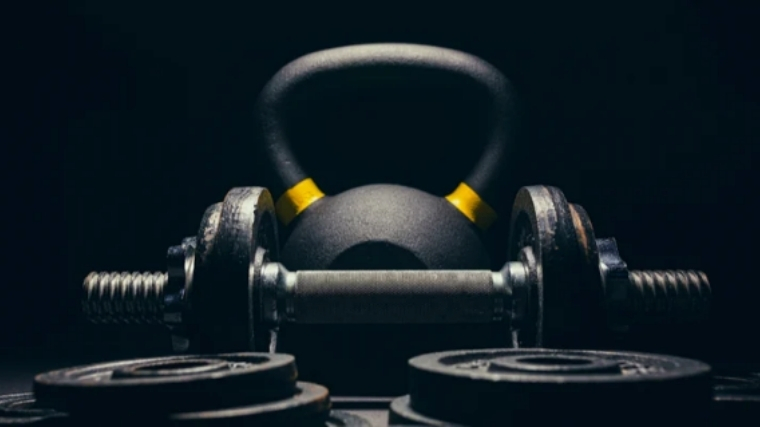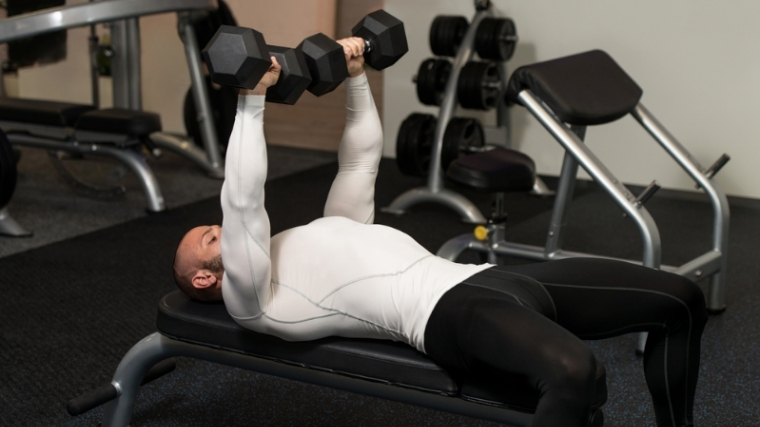Nowadays, gyms are chock full of tools — resistance bands, barbells, fancy squat racks — and it’s frankly overwhelming. Want to get lean and increase your power output? Better start swinging a kettlebell. Or, maybe you want to build muscle and carve an envy-inducing chest. Well, dumbbells are your best bet then, right? Not so fast. Both tools are useful, and both are readily available (well, pre-COVID at least). The question you should be asking isn’t, “Do I use kettlebells or dumbbells?” But how can either tool help me achieve my goals?
The guide below is designed to help you along the way. This article is not intended to sway you into using over the other, but to point out some considerations to consider when employing kettlebells and dumbbells.
The Differences Between Dumbbells and Kettlebells
To fully understand the context of when to employ the dumbbell and kettlebell in training, then it’s a good idea to first breakdown some key differences between them. For starters, you’ll notice both tools look very different. However, without a deeper knowledge of weight displacement, application to training, and biomechanics, the physical differences won’t mean much. Here’s a chart briefly outlining the main differences.
| Kettlebell Differences | Dumbbell Differences |
| The weight sits below the handle. | The weight is evenly displaced on both sides. |
| It’s constructed with cast-iron. | Its construction varies greatly |
| The handle can accommodate one or two hands. | The handle accommodates only one hand. |
[Related: The Best Kettlebells on the Market]
The above physical differences are pretty easy to see and wrap one’s head around, but understanding how those physical differences affect your training is crucial. Otherwise, how can you pick the right tool for the job?
The center of mass of these two implements is important to understand because it has the potential to shift the stress of the external load being put on the desired muscle and joint when performing any exercise. For example, curling a kettlebell will feel far different than curling a dumbbell.
A kettlebell or dumbbell’s center of mass will affect an exercises’ strength curve — which is how an exercise’s difficulty shifts throughout a range of motion. To take it a step further, a strength curve’s difficulty is not constant, as different implements will place different demands on the muscles/joints as they move through different ranges of motion. (1)

[Related: Single-Kettlebell Circuits You Can Do At Home]
Take bands or a machine on a preacher curl, for example. Both tools provide constant tension throughout the full range of motion, compared to a dumbbell’s strength curve, which is hardest when the tool is the farthest point away from the body. Thus, strength curves will vary based on the muscle and joints being used, along with the range of motion they’re working through and the implement chosen.
The same strength curve logic can be applied for kettlebells and dumbbells when assessing their use for certain exercises. Their center of mass is different, so how they create difficulty for various exercises in certain ranges of motion will vary slightly.
Dumbbells Vs. Kettlebells Breakdown
Here’s how each tool impacts your workouts based on specific goals — muscle growth, power output, and cardio.
For Muscle Activation
A study published in 2018 compared EMG activity of the anterior deltoid and pectoralis major when subjects performed either a seated dumbbell overhead press or a seated kettlebell overhead press. Both overhead presses were performed with equal loads.
The researchers suggested that the dumbbell overhead press had slightly higher anterior deltoid EMG (electromyography) than the kettlebell. (2) The authors then speculated that the difference in the anterior deltoid potentially had to do with the alignment of the dumbbell and kettlebell and how this might have affected the primary movers in the overhead press.

[Read More: The Best Shoulder Exercises for Bigger, Stronger Shoulders]
The dumbbell sits directly over the palm, while the kettlebell sits behind the wrist, which then creates a slight torque (external rotation) in the glenohumeral joint. This difference could have been why the dumbbells produced more muscle activity than the kettlebell, as its load was more direct and consistent on the primary movers of the overhead press (the shoulder muscles).
However, it’s worth noting that those were the only two muscles that authors investigated in this study, so the stabilizer muscles that are often suggested to be higher with kettlebell use were not explored.
So what could this potentially mean?
Research comparing the muscle activation elicited from dumbbells versus kettlebells is still sparse. That said, the information above — while not entirely conclusive — does offer food for thought.
When selecting between a dumbbell and kettlebell for muscle activation purposes, consider how they load the target muscles through the range of motion being trained. Likely, their differences are not large enough to warrant that big of a concern for most lifters. However, it can be still useful to consider the following:
- What are the exercise’s primary movers?
- What range of motion is being achieved?
- What’s the main goal with the exercise that’s been chosen? Strength, stability, hypertrophy, etc.?
By considering the above, you can take the best course of action for facilitating the desired adaptation. At the end of the day, quality programming and reps will weigh heaviest in the long run for strength and hypertrophy adaptations.
Which to Use: In short — both. But this depends on your goal. For strength, you’ll want to move more weight, and for that, you need stability. Generally, a dumbbell is more stable, so you should opt for those most time. However, a kettlebell’s off-center of gravity can challenge a muscle when loads aren’t a concern — making them a good pick for growth.
For Power
Kettlebells and dumbbells both have the potential to help improve a lifter’s power. The decision on which implement to use comes down to their ease of use and the exercise you’re performing.
Generally speaking, power-based training demands dynamic movements, and exercises will require higher velocities. Thus, kettlebells are usually a go-to for power because their construction is conducive to being moved around more forcefully and dynamically.

[Related: How to Do the Dumbbell Bench Press]
Movements like the kettlebell swing, clean & jerk, and snatch are all exercises that can be programmed for the adaptation of power that the dumbbell falls slightly short on. For example, a 2012 study published in the Journal of Strength & Conditioning Research suggested that kettlebell swings were a viable option for improving maximal and explosive strength production. (3)
When it comes to increasing power, it’s important to acknowledge the equation for power, as this can also help dictate the tool chosen.
- Power = Work / Time
For athletes trying to improve power, the kettlebell is generally a friendlier option based on its design and ease of use. The construction of a kettlebell and its traditional movements are useful for increasing the amount of work you can put in over a desired period of time.
Dumbbells are also viable options for increasing power. However, their construction limits the number of dynamic movements you can do (compared to kettlebells)
Which to Use: If you have them and based on the movements being performed, opt for kettlebells. However, dumbbells can suffice, but explosive exercises are more limited.
For Cardio
To improve your cardio, you need to sustain an elevated heart rate for a prolonged period of time. You can do this with either tool. Which to use comes down to the type of cardio you want to do. If you want to perform more full-body movements like swings, snatches, or figure-8 lunges — choose kettlebells.
However, you can get a pump while elevating your heart rate more easily with dumbbells. Pick a few muscle-building movements — like biceps curls, skull crushers, Pendlay rows — and crank out a bunch of reps with a lighter weight.
[Read More: The Best Bodyweight Exercises, + Workouts and Tips From a CPT]
It’s worth noting that kettlebells are usually the better bet when it comes to performing flows — which are a series of movements fluidly strung together into a circuit. (A dumbbell will work just fine depending on the exercises selected. When in doubt, keep it simple.) Compared to other forms of metabolic training, kettlebell HIIT training has been suggested to be a comparable and more sustainable option than sprint HIIT training. (4)
Which to Use: Both! Kettlebells will be slightly better when it comes to ease of use, but both are great options for cardio-focused workouts.
Kettlebells Vs. Dumbbells — What Really Matters?
At the end of the day, the differences between kettlebells and dumbbells go out the window without quality programming that accounts for multiple training variables, exercise selection, and an individual’s goals and needs.
The dumbbell and kettlebell are both great implements for targeting training various training adaptations. What matters most is quality programming that considers multiple factors that help direct lifters closer to their goals and needs.
[Related: The Best Home Workout Programs For Any Training Goal]
Wrapping Up
The dumbbell and kettlebell are both solid options for pushing personal fitness further. Both implements offer plenty of benefits, and their best uses come down to the context in which one plans to utilize them.
Frequently Asked Questions
Can beginners train with kettlebells?
Yes, absolutely. Beginners can train with kettlebells with no problem, however, it’s worth pointing out that form should take precedence of one’s focus when using them for the first few workouts.
What are the differences between kettlebells and dumbbells?
Kettlebells have a center of mass that falls below the handle, while dumbbells evenly displace weight on each side of the handle. This makes the dumbbell and kettlebell useful for certain exercises and adaptations, as each will be better suit for particular exercises!
If weight is equal, are the dumbbell and kettlebell different?
Yes, to an extent.
This question is better asked when you consider the movement being performed and rationale behind why it’s being performed. Both dumbbells and kettlebells work great for developing strength, power, and cardiovascular fitness, and what matter most is the quality of their movements and programming.
Can exercises like kettlebell swings be performed with dumbbell?
To a degree, but it won’t be ideal. The kettlebell’s handle is wider, so it fits two hands better and the weight is further from the body so it accommodates the swinging motion slightly better than what a dumbbell would do.
Can you just perform all exercises with a dumbbell or a kettlebell?
Yes, you can do whatever you wish! The only discrepancy that might come into play is the type of workout desired to be performed. For example, dumbbells will usually feel more natural to use during static strength movements, while kettlebells will feel much better during dynamic movements like cleans, swings, and snatches.
References
- McMaster, D., Cronin, J., & McGuigan, M. (2009). Forms of Variable Resistance Training. Strength And Conditioning Journal, 31(1), 50-64.
- JEREMY R. DICUS, C. (2018). Stability of Resistance Training Implement alters EMG Activity during the Overhead Press. International Journal Of Exercise Science, 11(1), 708.
- MA, L. (2020). Kettlebell swing training improves maximal and explosive strength. – PubMed – NCBI .
- RR, W. (2020). Comparison of Cardiorespiratory and Metabolic Responses in Kettlebell High-Intensity Interval Training Versus Sprint Interval Cycling. – PubMed – NCBI.
Featured image: MarinaP / Shutterstock